The Ceramic Tester Market is estimated to be valued at USD 205.0 million in 2025 and is projected to reach USD 346.9 million by 2035, registering a compound annual growth rate (CAGR) of 5.4% over the forecast period.
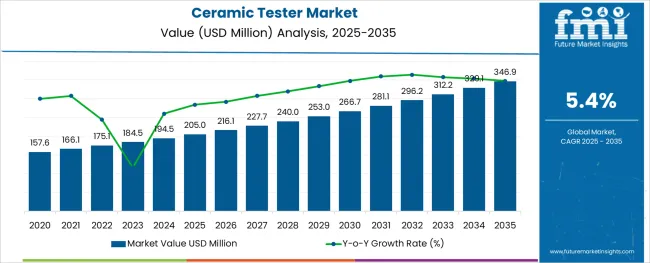
The ceramic tester market is experiencing steady growth driven by increasing demand for precise quality control in ceramics manufacturing. Advances in production technologies have heightened the need for reliable testing instruments that can measure material strength and durability accurately. Digital testing solutions have gained popularity for their ability to deliver real-time data and improve testing efficiency.
Growing electronics manufacturing activities have further expanded the need for ceramic testers, as ceramics are widely used in electronic components for insulation and heat resistance. Mechanical testing applications remain a major focus as manufacturers seek to ensure product reliability and compliance with safety standards.
The market outlook is positive, with further growth expected as industries adopt more automated and precise testing methods. Segment growth is anticipated to be driven by digital force gauges as the preferred type, the electronics sector as the leading end user, and mechanical testing as the primary application.
The market is segmented by Type, End User, and Application and region. By Type, the market is divided into Digital Force Gauge, Manual Ceramic Tester, Motorized Ceramic Tester, Pin Abrasion Ceramic Tester, and Other Types. In terms of End User, the market is classified into Electronics, Healthcare, Energy, Aerospace, Automotive, and Others. Based on Application, the market is segmented into Mechanical Testing, Chemical Composition, Materialography, and X-Ray Diffraction Analysis. Regionally, the market is classified into North America, Latin America, Western Europe, Eastern Europe, Balkan & Baltic Countries, Russia & Belarus, Central Asia, East Asia, South Asia & Pacific, and the Middle East & Africa.
The market is segmented by Type, End User, and Application and region. By Type, the market is divided into Digital Force Gauge, Manual Ceramic Tester, Motorized Ceramic Tester, Pin Abrasion Ceramic Tester, and Other Types. In terms of End User, the market is classified into Electronics, Healthcare, Energy, Aerospace, Automotive, and Others. Based on Application, the market is segmented into Mechanical Testing, Chemical Composition, Materialo graphy, and X-Ray Diffraction Analysis. Regionally, the market is classified into North America, Latin America, Western Europe, Eastern Europe, Balkan & Baltic Countries, Russia & Belarus, Central Asia, East Asia, South Asia & Pacific, and the Middle East & Africa.
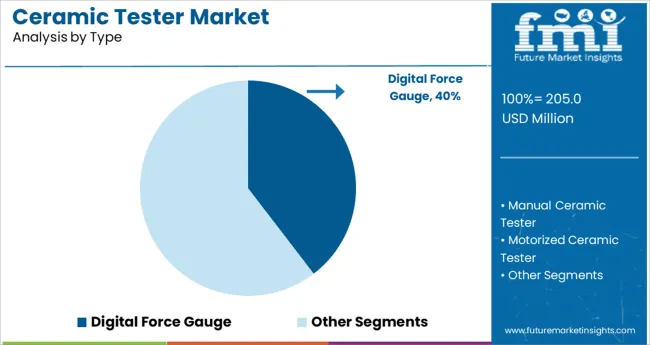
The Digital Force Gauge segment is expected to hold 39.6% of the ceramic tester market revenue in 2025, leading the type category. This segment’s growth is attributed to its precise force measurement capabilities and user-friendly interface. Digital gauges provide immediate feedback which supports faster quality assessments and reduces testing errors.
Their compatibility with automated systems has encouraged adoption in modern manufacturing facilities. The growing emphasis on data accuracy and process control in ceramic production has increased reliance on digital instruments.
As testing processes become more integrated with digital platforms, the demand for digital force gauges is projected to continue its upward trend.
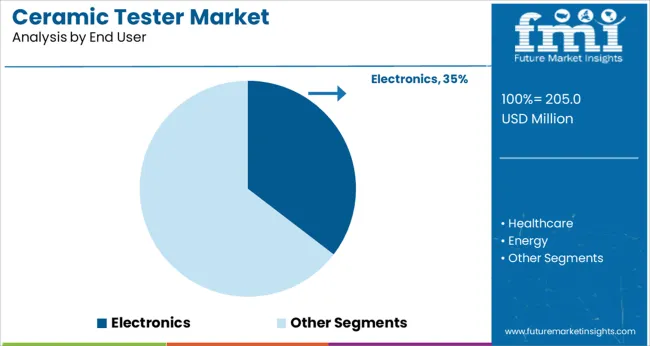
The Electronics segment is projected to represent 35.4% of the ceramic tester market revenue in 2025, maintaining its position as the largest end-user category. Ceramics are extensively used in electronic devices for insulation and thermal management, requiring rigorous testing to meet industry specifications.
The increasing complexity of electronic components has necessitated precise material characterization to ensure performance and durability. Electronics manufacturers have invested heavily in quality assurance protocols which include ceramic testing as a critical step.
This focus on reliability and compliance in electronics production has sustained demand for ceramic testers in this sector.
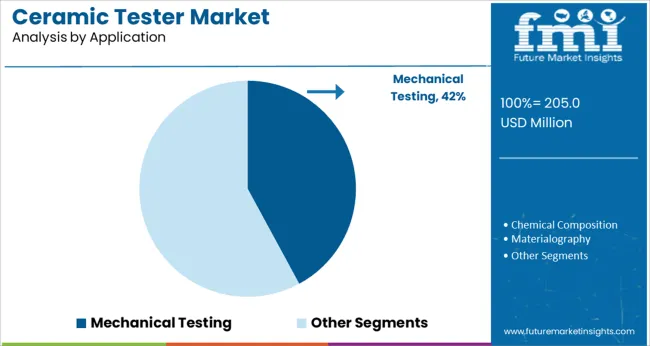
The Mechanical Testing segment is anticipated to account for 42.1% of the ceramic tester market revenue in 2025, making it the dominant application segment. Mechanical testing involves assessing properties such as strength, hardness, and fracture resistance which are crucial for ceramics used in structural and functional applications.
Manufacturers across industries rely on mechanical tests to verify material integrity and adherence to standards. Increasing regulatory requirements and quality benchmarks have reinforced the need for robust mechanical testing solutions.
As the demand for high-performance ceramics grows, so will the need for reliable mechanical testing to ensure product safety and functionality.
Rising adoption of ceramics across various industries including automotive, healthcare, and electronics, presence of stringent regulations, and technological advancements in ceramic testers are some of the major factors driving the growth in ceramic tester market.
Ceramic testers have become highly sought-after testing equipment used across industries for measuring the mechanical properties of ceramics. They enable end users to a get better assessment of the tested product so that it can be used for specific purposes.
The continuous search for light weight and high strength materials in automotive has prompted automotive manufacturers to use ceramics in their vehicles. However, before using them, they ensure that these ceramic materials are durable and strong so that they can withstand extreme conditions. For this purpose, they employ ceramic testers.
Similarly, introduction of various stringent regulations and standards set by organizations like the International Organization for Standardization (ISO) and American Society for Testing and Materials (ASTM) for testing of properties of ceramic is positively impacting the growth of ceramic tester market and the trend is likely to continue during the forecast period.
Despite rising applications of ceramic testers, there are certain factors that are limiting the growth of ceramic tester market. Some of these factors include variation in regulations across several countries, higher cost of advanced ceramic testers, and low penetration of these products across lower economies.
Amid booming automotive and electronics industries Asia Pacific is expected to account for a significant share of the global ceramic tester market during the forecast period. Growth in the Asia Pacific ceramic tester market is driven by increasing need for measuring the properties and performance of ceramics, presence of leading ceramic tester manufacturers, rising consumer spending in electronic products, and increasing usage of ceramics in automotive industry.
Demand for ceramic testers is especially rising across countries like China and India due to flourishing electronics and automotive industries. These industries are increasingly using ceramics in vehicles and electronic products. However, before using them, they use ceramic testers to test the strength and durability of ceramic materials.
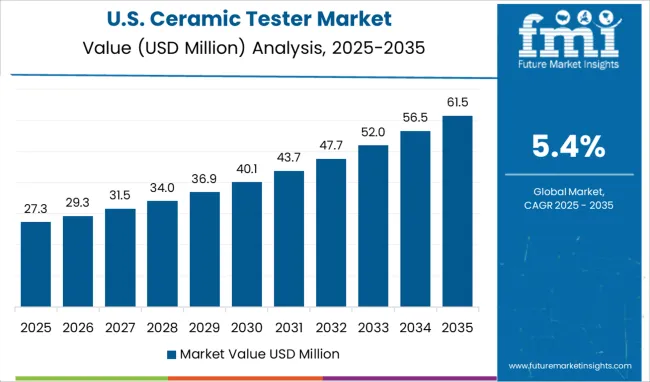
According to Future Market Insights, the North America Ceramic Tester Market, spearheaded by the USA, is expected to grow at a significant pace during the forecast period, owing to the rising demand for ceramic testers from diverse industries such as healthcare, automotive, aerospace.
Similarly, increasing adoption of ceramics in automotive and energy industries is generating demand for testing equipment like ceramic testers across countries like the USA, and Canada and this trend is likely to continue during the forecast period.

Some of the key participants present in the global ceramic tester market include AMETEK.Inc., EIE Instruments, E.J.Payne Ltd, OPF Enterprises, LLC, Shimadzu Scientific Instruments, C-tech Instruments, IMR Test Labs, OFI Testing Equipment, Inc., Aimil Ltd., Centro Ceramico, and others.
The global ceramic tester market is highly dynamic in nature with key market players continuously focusing on expanding their product portfolios by launching advanced products. Besides this, they have adopted growth strategies such as mergers, partnerships, price reduction, and strengthening of distribution channels to increase their customer bases and gain a competitive edge in the market.
| Report Attribute | Details |
|---|---|
| Growth Rate | CAGR of 5.4% from 2025 to 2035 |
| Projected Growth Rate (2025) | ~USD 205 Million |
| Base Year for Estimation | 2024 |
| Historical Data | 2020 to 2024 |
| Forecast Period | 2025 to 2035 |
| Quantitative Units | Revenue in million and CAGR from 2025 to 2035 |
| Report Coverage | Revenue Forecast, Volume Forecast, Company Ranking, Competitive Landscape, Growth Factors, Trends and Pricing Analysis |
| Segments Covered | Type, Application, End-Use Industry, Region |
| Regions Covered | North America; Latin America; Western Europe; Eastern Europe; APEJ; Japan; Middle East and Africa |
| Key Countries Profiled | USA, Canada, Brazil, Argentina, Germany, UK, France, Spain, Italy, Nordics, BENELUX, Australia & New Zealand, China, India, ASEAN, GCC, South Africa |
| Key Companies Profiled | C-tech Instruments; EIE Instruments; E.J.Payne Ltd; AMETEK.Inc.; OFI Testing Equipment, Inc.; EIE Instruments; E.J.Payne Ltd; Aimil Ltd.; IMR Test Labs; Shimadzu Scientific Instruments; Centro Ceramico; OPF Enterprises, LLC; Others |
| Customization | Available Upon Request |
The global ceramic tester market is estimated to be valued at USD 205.0 million in 2025.
It is projected to reach USD 346.9 million by 2035.
The market is expected to grow at a 5.4% CAGR between 2025 and 2035.
The key product types are digital force gauge, manual ceramic tester, motorized ceramic tester, pin abrasion ceramic tester and other types.
electronics segment is expected to dominate with a 35.4% industry share in 2025.






Full Research Suite comprises of:
Market outlook & trends analysis
Interviews & case studies
Strategic recommendations
Vendor profiles & capabilities analysis
5-year forecasts
8 regions and 60+ country-level data splits
Market segment data splits
12 months of continuous data updates
DELIVERED AS:
PDF EXCEL ONLINE
Ceramic Textile Market Size and Share Forecast Outlook 2025 to 2035
Ceramic and Porcelain Tableware Market Size and Share Forecast Outlook 2025 to 2035
Ceramic Matrix Composites Market Size and Share Forecast Outlook 2025 to 2035
Ceramic Frit Market Size and Share Forecast Outlook 2025 to 2035
Ceramic Substrates Market Size and Share Forecast Outlook 2025 to 2035
Ceramic 3D Printing Market Size and Share Forecast Outlook 2025 to 2035
Ceramic Injection Molding Market Size and Share Forecast Outlook 2025 to 2035
Ceramic Tableware Market Size and Share Forecast Outlook 2025 to 2035
Ceramic Paper Market Size and Share Forecast Outlook 2025 to 2035
Ceramic Balls Market Size and Share Forecast Outlook 2025 to 2035
Ceramic Membranes Market Analysis - Size, Share and Forecast Outlook 2025 to 2035
Ceramic Barbeque Grill Market Analysis - Size, Share, and Forecast Outlook 2025 to 2035
Ceramic Tiles Market Growth & Trends 2025 to 2035
Ceramic Sanitary Ware Market Trends & Forecast 2025 to 2035
Ceramic Transducers Market Growth - Trends & Forecast 2025 to 2035
Leading Providers & Market Share in Ceramic Barbeque Grill Industry
Ceramic Ink Market
Ceramic Coating Market Growth – Trends & Forecast 2024-2034
Ceramic Additives Market
Ceramic Insulator Market

Thank you!
You will receive an email from our Business Development Manager. Please be sure to check your SPAM/JUNK folder too.
Chat With
MaRIA